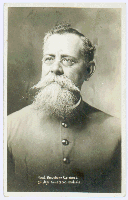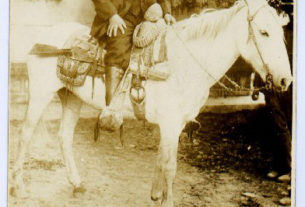Villa broke jail on Christmas Eve and was in El Paso when Huerta engineered the coup that overthrew Madero. In February 1913 Huerta staged a fake 10-day artillery duel with a fake rival, Felix Díaz, nephew of the old dictator. The battle was phony only in the sense that Huerta and Díaz were secretly in cahoots — the loss of life to civilians was all too real. Purpose of the spurious engagement was to create a state of confusion in which Huerta could seize power from Madero. Madero was deposed on the 18th and four days later he and his vice-president, José Pino Suarez, were shot to death after being removed from their jail cells. Nobody believed Huerta’s story that the two men had been killed in the crossfire when a rescue was attempted.
A particularly sinister role in Madero’s overthrow was played by the U.S. ambassador, Henry Lane Wilson. An aggressive advocate of dollar diplomacy who was temperamentally drawn to Huerta — both were alcoholics — Wilson detested Madero and was involved up to his neck in Huerta’s consiracy to overthrow him.

Huerta set himself up as a military dictator but soon faced a challenge from the north. His enemies were Pancho Villa, a former federal senator named Venustiano Carranza and an ambitious, iron-willed ex-schoolteacher from Sonora named Alvaro Obregón (link Obregón.) Adding to Huerta’s troubles was the U.S. occupation of Veracruz. This action stemmed from Mexico’s refusal to give a twenty-one gun salute as an apology for having arrested nine American bluejackets who allegedly entered a prohibited zone in Tampico. Throughout 1913-14 Huerta’s forces were steadily driven back toward the capital. The campaign’s most memorable engagement was the June 23, 1914 capture of Zacatecas by Villa’s superbly equipped División del Norte (“Division of the North”). Zacatecas finished Huerta. He resigned June 15 and two days later he was on a German freighter bound for Spain.
Victory over Huerta did not bring peace but a new clash between revolutionary leaders that pitted Villa and Zapata against Carranza and Obregón. At first Villa-Zapata had the upper hand, with the leaders holding an epic December 4, 1914 meeting in Mexico City following an abortive convention in Aguascalientes. Then the tide began to turn. Carranza’s forces, known as the Constitutionalists, had been bottled up in Veracruz but bit by bit, thanks mainly to the superb generalship of Obregón, they began to prevail against the Zapatistas and Villistas.
By April 1915 World War I had been raging for six months. Though Obregón was without formal military training, he studied the trench warfare tactics of the Western Front and used them to defeat Villa in two crucial battles at Celaya, Guanajuato. He then drove Villa north — losing an arm in one engagement — and by the end of 1915 Villa was reduced to pretty much what he’d been at the outset of the Revolution: a marauder prowling the Chihuahua sierra.
As for the Zapatistas, they really weren’t interested in extending their domain outside their jungly and mountainous home state of Morelos. There the Revolution had been won. They seized Puebla but made no further move toward reducing Carranza’s stronghold in Veracruz.
The Carranza-Obregón forces, which now controlled most of Mexico, received a big boost when the United States extended de facto recognition to Carranza on October 19, 1915. This infuriated Villa, who had always been friendly to the U.S., and led to the March 1916 villista raid on Columbus, New Mexico. The attack claimed the lives of eight American soldiers and ten civilians and resulted in the so-called Punitive Expedition of 1916-17, when American cavalry units under General “Black Jack” Pershing wandered through northern Mexico for ten months but completely failed in their attempt to capture Villa.
Carranza, who had been ruling provisionally (he was known by followers as “the First Chief”), officially became president on March 11, 1917, in an election in which he won 797,305 votes against the 11,615 garnered by his closest rival. A month before, on February 5, the Constitution of 1917 was adopted. It was this charter, (link 1917 Constitution) that so infuriated Catholics with its anticlerical provisions.
Although the 1917 Constitution also contained provisions to improve the lot of workers and peasant farmers, these were ignored by the Carranza government. Corruption was endemic and strikes were mercilessly broken. But Carranza did manage to rid himself of a major enemy: Emiliano Zapata. Zapata was slain April 10, 1919, being led into a trap by Col. Jesús Guajardo, a federal officer who set up the ambush by pretending to defect to the Zapatistas.
Obregón had gone into temporary retirement, returning to his native Sonora to raise chick peas. But on June 1, 1919, he declared his candidacy for the June 1920 presidential election. In the fall of 1919 Carranza announced that he would be supporting Ignacio Bonillas, then Mexican ambassador in Washington.
It was a disastrous choice. Bonillas, an M.I.T. graduate, had spent so little of his life in Mexico that political enemies claimed he had difficulty speaking the language of his ancestors. They derisively called him “Meester” Bonillas and the clever Obregón lost no time tapping into this sentiment. During the campaign pro-Obregón railroad workers kept Bonillas from making a scheduled appearance by derailing his train. Deliberately fabricated rumors then went out that Bonillas had canceled the appearance because it interfered with a Spanish lesson he was taking.
Carranza retaliated with a reign of terror against Obregón campaign workers. Obregón, fearing that he was about to be arrested, fled Mexico City and took refuge in Chilpancingo, capital of Guerrero state. On April 20 he announced that he was giving up the presidential campaign and would take arms against Carranza.
The Carranza regime collapsed like a house of cards. While generals went over to Obregón en masse, Carranza and his corrupt followers loaded up an eight-car “Golden Train” with all the money and valuables they could lay their hands on and prepared to leave for Veracruz. During the journey, attacks on the “Golden Train” caused Carranza to abandon it in an attempt to escape on foot. On May 20, in a hut near the Puebla village of Tlaxcalantongo, he was treacherously murdered in his sleep by followers of a local bandit-turned-general named Rodolfo Herrero. Herrero had previously welcomed Carranza and promised him refuge.
On June 1 Governor Adolfo de la Huerta of Sonora was installed by Congress as interim president.
In the regular election, held October 26, 1920, Obregón defeated Alfredo Robles Domínguez, a candidate backed by the Catholic Church, by a 1,131,751 to 47,442 margin. At midnight of November 30, Alvaro Obregón raised his remaining arm and took the oath of office.
The most tumultuous phase of the Mexican Revolution was now over. In a classic application of the natural selection process, the toughest, smartest, and most ambitious of Mexico’s revolutionary leaders had successfully eliminated his rivals and was now alone at the top.
The Mexican Revolution:
A Nation in Flux – (1910-20) Part 1 -|- The Consolidation (1920-1940) Part 1


